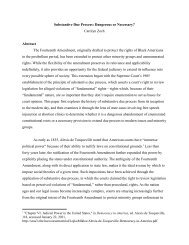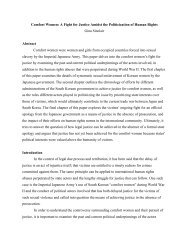Brown Undergraduate Law Review — Vol. 2 No. 2 (Spring 2021)
We are proud to present the Spring 2021 issue of the Brown Undergraduate Law Review. We hope that the works contained herein offer insight and inspiration to all who read them.
We are proud to present the Spring 2021 issue of the Brown Undergraduate Law Review. We hope that the works contained herein offer insight and inspiration to all who read them.
Create successful ePaper yourself
Turn your PDF publications into a flip-book with our unique Google optimized e-Paper software.
more care has not been shown to produce better results:<br />
though patients may gravitate toward the seeming security<br />
of ?more aggressive medical care,? patients in regions<br />
favoring aggressive care tend to have poorer health<br />
outcomes and lower satisfaction rates. 58 The quality of<br />
medical care is not meaningfully predicted by its quantity,<br />
nor does an influx of medical information result in<br />
higher-quality patient experiences.<br />
Fearing increased liability and anticipating disruptions to<br />
their professional practice, physician groups? efforts to<br />
revise Wis. Stat. §448.30 succeeded when Wisconsin<br />
adopted a new informed consent statute in 2013.<br />
Abandoning its prior reasonable patient standard, the<br />
updated statute instead deferred to the reasonable<br />
physician to determine informed consent, as well as<br />
clarifying that physicians must no longer disclose<br />
?information about alternate medical modes of treatment<br />
for any condition the physician has not included in his or<br />
her diagnosis at the time the physician informs the<br />
patient.? 59 While professional custom may not reliably<br />
dictate the most effective means of risk disclosure,<br />
Wisconsin?s lawmakers ultimately agreed that a legal<br />
remedy was the wrong prescription: ?[J]udges and juries<br />
ought not [play doctor].? 60<br />
Whose Reason Rules: State by State, Divergent<br />
Standards<br />
Standardizing Autonomy: Medical Communication, Liability, and the Doctrine of Informed Consent<br />
Since Canterbury v. Spence, two broad standards have<br />
emerged by which informed consent cases are adjudicated<br />
in the United States. Some states (about half) have<br />
privileged patients? self-determination over professional<br />
tradition by adopting a version of Canterbury?s reasonable<br />
patient standard, which gauges the adequacy of physicians?<br />
disclosure based on what a reasonable patient would<br />
consider important to their medical decision.<br />
61 62<br />
Meanwhile, other states have decided against the<br />
patient-centered standard, questioning its feasibility and<br />
fairness. Such states have determined that a<br />
physician-defendant?s disclosure should be judged against<br />
the customary practices of fellow doctors in the<br />
community, an approach known as the reasonable<br />
physician or professional standard. The distinction<br />
between these standards appears to tangibly influence the<br />
outcomes of informed consent lawsuits: research has<br />
demonstrated that states with a reasonable physician<br />
standard are significantly less likely to rule in patients?<br />
favor. 63<br />
Indiana is one such state. In the case of Culbertson v.<br />
Mernitz (1992), Patty Jo Culbertson?s cervix improperly<br />
adhered to the wall of her vagina following a bladder<br />
suspension and cryosurgery performed by Dr. Roland<br />
Mernitz? a complication for which Culbertson underwent<br />
subsequent surgery by another doctor. When Culbertson<br />
filed an informed consent suit against Dr. Mernitz claiming<br />
that he failed to disclose the surgery?s ?inherent risks and<br />
complications,? Dr. Mernitz requested summary judgment<br />
based on a medical review panel?s assessment of the<br />
case. 64 Despite acknowledging Dr. Mernitz?s lack of<br />
58. Elliott Fisher et al., ?The Implications of Regional Variations in Medicare Spending. Part 2: Health Outcomes and Satisfaction with Care,?<br />
Annals of Internal Medicine 138, no. 4 (February 2003):<br />
59. Wis. Stat. § 448.30, Informed consent.<br />
60. Jandre, 813 N.W.2d 671.<br />
61. Canterbury, 464 F.2d 787 (quoting Waltz & Scheuneman). (?In broad outline, we agree that ?[a] risk is thus material when a reasonable person, in<br />
what the physician knows or should know to be the patient?s position, would be likely to attach significance to the risk or cluster of risks in deciding<br />
whether or not to forego the proposed therapy.??)<br />
62. Sawicki, 9. (?In the United States, jurisdictions are more or less evenly divided between a patient-based standard and a physician-based standard<br />
for identifying the information that must be disclosed as part of the informed consent process.?)<br />
63. Studdert et al., ?Geographic Variation in Informed Consent <strong>Law</strong>,? 115?117.<br />
64. Culbertson v. Mernitz, 602 N.E.2d 99.<br />
<strong>Brown</strong> <strong>Undergraduate</strong> <strong>Law</strong> <strong>Review</strong><br />
40










